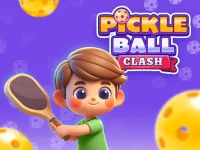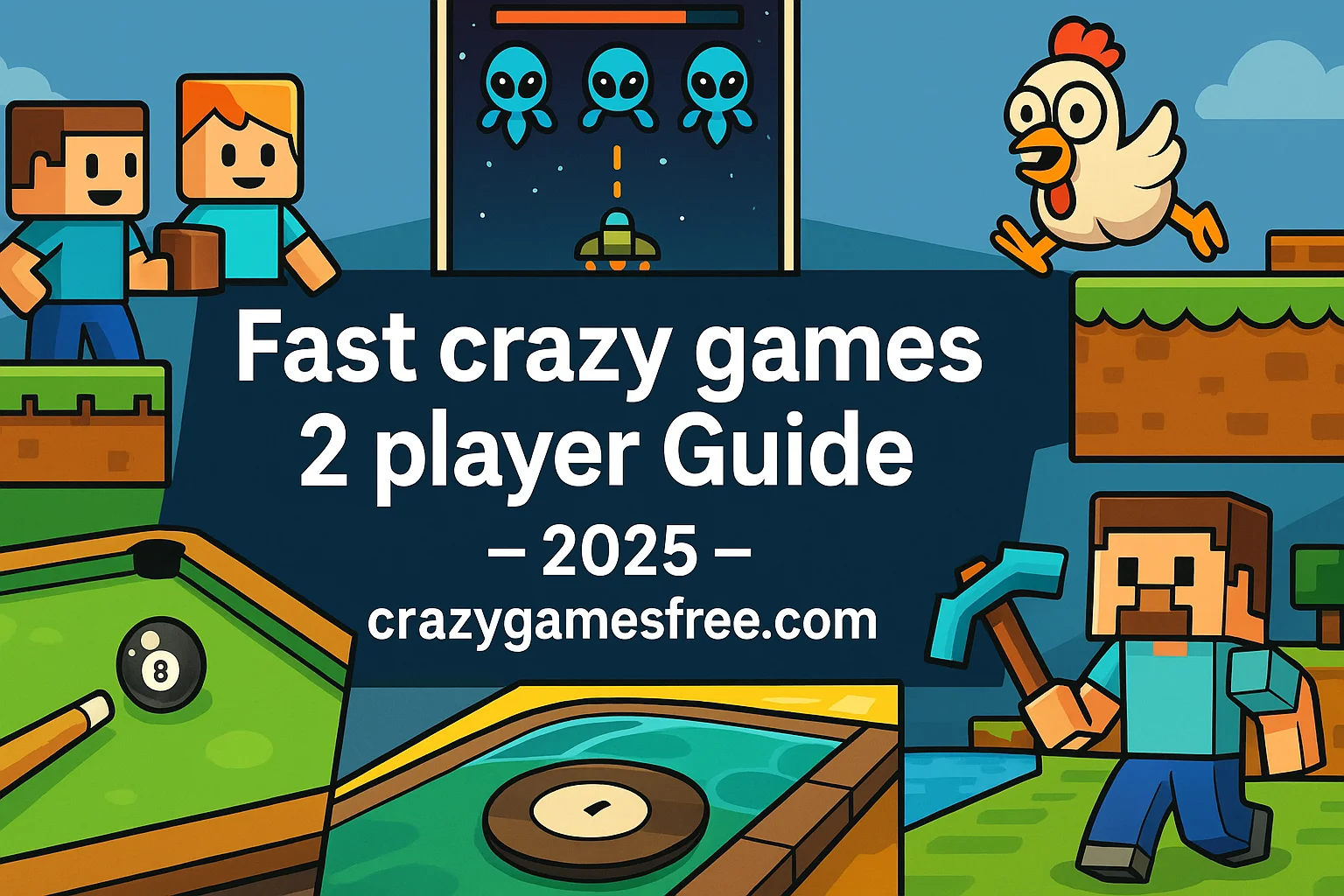
Pickle Ball Clash

Xtreme Good And Bad Boys 2 2025

FRAGMENT

Feed Monster Game

Sky Bus Mega Ramp Drive

Arrow Survival: 15 Seconds

Minecraft Unblocked Online

School Stories: Teacher Sim

Bubble Shoot Merge Box 2048

Girl Games Unblocked: Mini Fun

Bid Wars 1 Auction Simulator

Single Line: Drawing Puzzle

Newborn Baby Care

Color Yarn Sort

Fix Da Brainrot

Two players, one browser, instant action — that’s the whole pitch. The best crazy games 2 player picks get you from click to clash in seconds, then keep you hooked with quick rematches and clean reads: see the setup, make a decision, own the result. It’s perfect for a five-minute reset between tasks, and it scales into sweaty best-of-five sets when you both start calling out patterns and counter-plays.
Local split on one keyboard, hot-seat for turn-based titles, or online 1v1 — all three styles work because the feedback loop is fast and honest. Learn the opener in a minute, then spend the next half hour shaving mistakes like a speedrunner.
If you want a single jump-off, Start crazy games 2 player instantly and time how long it takes to grab your first clean win.
At its core, this category is about tight loops and shared focus: one of you applies pressure while the other dodges, counters, or syncs up on a joint objective. Rounds are short, restarts are immediate, and the rules stay readable so you can focus on choices, not menus. In design terms, it sits squarely in the duo space — short sessions with high feedback — exactly the territory described by Two-player game. Expect three common flavors: competitive duels (best-of-X), cooperative problem-solvers (shared goals), and pass-and-play turn-takers (low stress, couch-friendly). If you can learn the loop in sixty seconds and you’re grinning by minute two, the game is doing its job.
Setup. Desktop is king for precision; tablets shine for pass-and-play puzzles. Sit shoulder-to-shoulder for local splits and agree on who gets WASD vs Arrow Keys before game one — it saves a lot of mid-round fumbles.
Controls. Expect WASD/Arrows for movement, Space/Shift/Ctrl for actions. Some micro-duels lean mouse-only; touch works fine for slower builders. If remapping exists, do it once and never change it.
Modes. You’ll see Local 2P, Online 1v1, and Co-op toggles. Best practice: run a 60-second solo lab to learn timing, then switch to 2P so your first duel isn’t a public tutorial.
Saves. Most titles store progress locally. Clearing cache or swapping devices usually resets. Treat PBs and unlocks like daily goals: fun to chase, not sacred.
Performance. Close heavy tabs, go fullscreen, and keep background apps light. These games are small but still benefit from a focused machine.
Accessibility. Agree on callouts up front (“you kite, I build,” “you anchor mid, I flank”). Short, specific comms beat monologues every time.
Read first, flex later. Your opening round is for pattern scouting — identify the safe option in common spots and write it into muscle memory.
Pick a win condition. In duels it’s usually tempo (steal turns) or positioning (control space). In co-op, split roles clearly and stick to them.
Micro-drills work. Run three identical openers; if a strat fails twice, pivot. Don’t romanticize losing lines.
Punish habits. If they always jump on beat three, bait and cover it. If they turtle, farm free resources until they tilt.
Reset the head. After two losses, take 30 seconds to breathe and stretch. Tilt is real; don’t let it pilot you.
Scale sessions. Five-minute bursts to groove mechanics; longer sets to learn counters and matchup flow.
House rules help. First-to-five, loser calls one adjustment for the next game. That’s built-in coaching without the ego.
“Two player” here covers local split, online duels, and pass-and-play. Keyboard split is best for precision titles; mouse wins aim-centric microgames; touch is great for puzzles and builders. Saves are usually device-bound, so expect resets when you clear cache or switch hardware. At school or work, networks may block games; if you can play, keep sessions tight and low-key. “No download” just means it loads straight in your browser — no installers, no accounts necessary.
Two brains, one build. The first minute trains division of labor: one player scouts and gathers, the other drafts a tiny plan and places with intent. The magic is how fast you feel productive — you enter a loop of grab → craft → wall → defend that punishes greedy detours and rewards clean callouts. Short sessions are perfect for “micro-project” challenges (a farm, a hideout, a mini-arena), while longer grinds become a masterclass in risk management and resource timing. You’ll start seeing the map like a blueprint, shaving waste and doubling down on the plays that buy you daylight. If that rhythm is your vibe, pause the theory and, mid-discussion, Discover BlockCraft Together in your browser to benchmark your duo’s build speed over three runs.
Pure routecraft with a party-game grin. You’re sprinting lanes, scooping objectives, and cutting off angles while deciding when to bank points and when to go greedy. The opener rewards pathing discipline: tighter corners, smarter denials, cleaner exits. In short bursts, this is a best-of-five chaos engine where momentum matters more than perfection; in long sets, it becomes a duel of feints and counter-routes as you read habits and sell fake lines. Expect “laughing through the clutch” moments and post-round breakdowns like a sports huddle. If you want to stress-test your consistency under noise, take a breath mid-banter and Try Trallero Tung Tung Chicken for free — loser explains their worst route, then you both rerun it clean.
Arcade DNA, modern restraint. Your whole game is target priority plus cooldown timing — panic-spam and you burn windows, hold discipline and you flip rounds from behind. The first minute teaches the difference between pressure and waste; the rest of the session drives it home as tiny leads snowball into wave control. Ten-minute sprints feel like a training montage, and longer sets reward pattern recognition until your cursor moves before you do. If you’re ready to see whether patience beats button-mashing, mid-wave Play Alien Clicker Invaders online and count how many cycles you can run without a single panic click.
Fundamentals clinic disguised as a chill duel. It starts with feel — contact points, pocket speed, cue-ball travel — then blossoms into a positional chess match where your “safe” shot sets traps two turns ahead. Best case is pass-and-play on one device for clean reps and quick rematches, but you can dial up the heat with house rules (call pockets; ball-in-hand on scratches; race to five). Expect to talk routes after misses and celebrate the tiny adjustments that turn “close” into “certain.” If you’re chasing patient, repeatable skill, take your stance and Discover Billiard Diamond Challenge in your browser — give each other one coaching note per frame and watch the quality spike.
Sandbox, but social on a clock. The loop is set a goal → split roles → iterate: builder vs gatherer, scout vs defender, planner vs executor. Your first minute is tool progression and don’t-die management (watch dusk, stash a buffer, craft the essentials). Short sessions produce tidy micro-projects; longer ones create shared “remember when…” stories embedded in the world. The joy is that everything scales: tiny farms become compounds, rough shelters become style showcases, and your teamwork becomes the content. If you want a low-friction canvas for duo creativity, take a quick snack break and Play Minecraft Unblocked Online free, then run a 30-minute build-off — same materials, two styles, judge on function and flair.